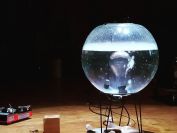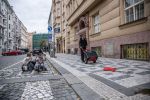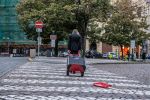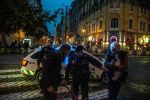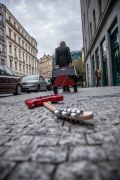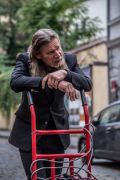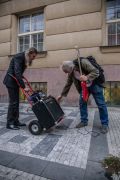A site and situation specific performance, *Grounding*, is an interdisciplinary work and integrates various ideas formally in a simple way. It is an artistic ritual-like performance where a brand new musical instrument is sacrificed as it is been played. A performer, dressed in black, walks ceremonially, slowly pulling a guitar amp on hand truck attached to a iconic electric guitar, a Fender Stratocaster, being dragged along the ground a few meters behind. The guitar is dragged face down, and the strings are played by the surface of the ground. The loud amplified sound changes with every step. It calls people to join the procession. At the end of the performance the guitar is has been destroyed.
Grounding by Roi Vaara is an art work which integrates various ideas in a simple way.
1. A performer, dressed in black suit, walks ceremonially, slowly pulling a guitar combo on hand truck. The amp is attached to a iconic symbol of Pop music - electric qutair - the walker drags it on the ground a few meters behind, attached with a sound cable.
It is an artistic ritual-like performance: a brand new musical instrument - Fender Stratocaster is sacrificed as it is played.
2. It is a noise urban symphony: the guitar is dragged "face down" so the strings are touched and triggered by the uneven surface of pavement, so the loud amplified sounds change with every tiny movement of the musician. At the end of the walk the rather expensive guitar is usually destroyed.
3. It is an intervention in the public space - amplified sonical event challenges citizen's patience, it invites some of pedestrians to listen or to join the procession.
4. It is a rock concert: Roi Vaara is skilled guitar player, especially interested in electric blues and work of musicians as Moody Waters, Howlin Wolf, or Lighting Hopkins. The way he is treating the Fender Stratocaster guitar refers to style of Jimi Hendrix, Sonny Sharrock or Thurston Moore. It is not related to the video piece of Christian Marclay Guitar Drag (1999).
4. It is a visual situation as it is a sonic situation: the lonely pilgrim in black suit, sometimes with black hat moves very slowly through streets. Without facial interaction with people and surrounded by electric noise, usually connected with crowd rock performances and ecstatic movements of musicians.
Roi Vaara (1953) is a pioneer in video, installation, performance and collective arts in Finland, and internationally best known for his performances. His background is in visual art and improvisational sound works. As soon as the elemental groundwork of his art became clear, he rejected the conventional genre based art disciplines to work on site and situation specific interdisciplinary art forms in a live context. Vaara has been performing since 1978, and since 1988, he has been active in the performance collective Black Market International whose mode of operation is based on the free and open exchange of ideas.
Vaara has performed over 500 unique experimental works. His art has been presented in numerous international exhibitions and festivals in some 50 countries worldwide. He is one of the founders of Muu ry (1987), an association for interdisciplinary art in Finland and has been an honorary member since 2012. He has written about art, worked as visiting lecturer and teacher in numerous universities and art academies around the globe, and he has curated and organized performance art programs. Poikkeustila (Exceptional State or State of Alarm) in 1999 was the first and until now the only nationwide performance art festival in Helsinki. In 2001 Vaara organized EXIT Festival in Helsinki, described as the “Woodstock Festival of Performance Art,” which presented the works of about 300 artists from 34 countries. His performance Artist's Dilemma (1997) became an international hit on video and in 2006 became the emblem of the 47th October Salon in Belgrade, subtitled Art, Life & Confusion (curated by René Block).
Vaara was born in 1953 in Moss (Norway) of Finnish parents. He studied art at the University of Art and Design (now Aalto University) from 1972–75 in Helsinki and at the Jyväskylä University from 1976–77 in Finland. He was granted a state award from the Arts Council of Finland in 2000 and the Niinistö Foundation's Ars Fennica Prize in 2005. In 2010 he was nominated (by Esther Ferrer) for the 5x5 CASTELLÓ International Art Prize and was awarded Pro Finlandia Medal of the Order of the Lion. Roi Vaara lives and works in Helsinki and Budapest.
Prepared by: GHMP and Agosto Foundation.
